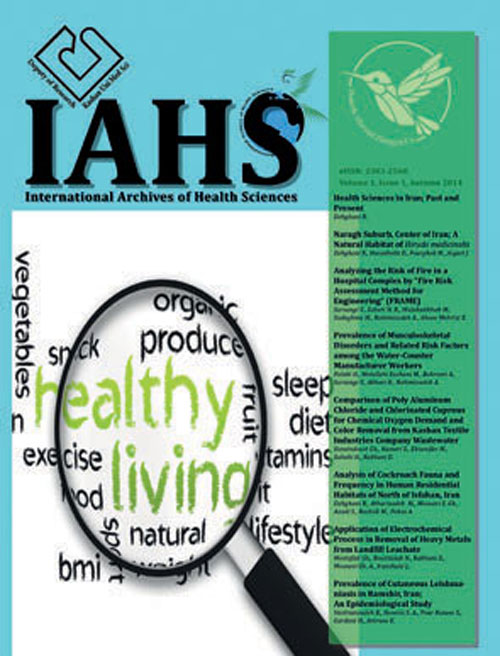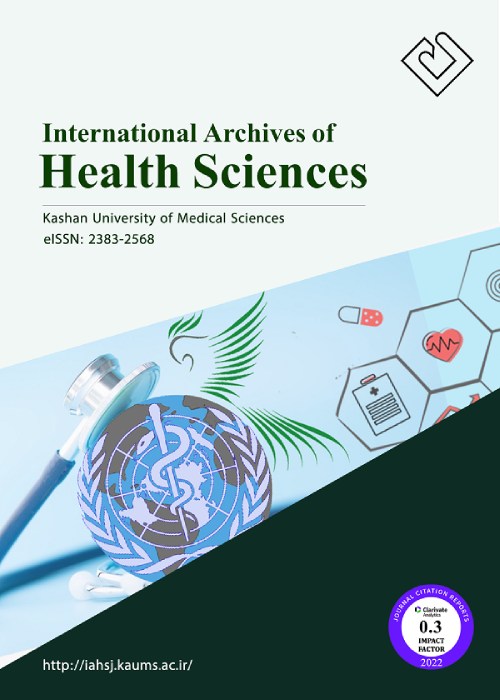فهرست مطالب

International Archives of Health Sciences
Volume:3 Issue: 1, Jan-Mar 2016
- تاریخ انتشار: 1395/01/19
- تعداد عناوین: 5
-
-
Photo-Catalytic Activity of ZnO Supported on H-ZSM-5 Zeolite to Reduce Cr(VI) from Aqueous SolutionsPages 1-6Aims: The application of photocatalytic processes to remove heavy metals in aqueous solutions and industrial wastewater are regarded as extremely effective, clean and without producing waste methods. The goal of the present study was to investigate the photocatalytic activity of ZnO based on H-ZSM-5 zeolite support.Materials and MethodsZnO/H-ZSM-5 composite synthesized by impregnation method successfully, and photo-reduction of Cr(VI) was investigated via this composite in present of UV light irradiation. The prepared composite was characterized by X-ray Diffraction (XRD) and Field Emission Scanning Electron Microscopy (FESEM). Data was analyzed by repeated measurement statistical test.
Findings: ZnO/H-ZSM-5 (79.5%) had better removal photo-reduction activity than pure H-ZSM-5 (8.7%; p=0.003) zeolite and ZnO (58.8%; p=0.003). The initial concentration of Cr(VI) was a highly influential factor in photo-reduction of Cr(VI); In the way that when the initial concentration increased from 10 to 40mg/l, the photo-reduction percentage decreased from 92.5 to 57.7% in constant operational conditions (p=0.001).ConclusionZnO/H-ZSM-5 composite has higher removal photo-catalytic activity than pure ZnO and HZSM-5 zeolite. Photo-reduction of Cr(VI) by ZnO/H-ZSM-5 composite is an efficient technology for the treatment of water and wastewater containing high concentration of Cr(VI).Keywords: Oxidation, Reduction, Hexavalent Chromium, Metals, Heavy -
Pages 7-12Aims: A few studies concentrate on the level of knowledge of HPV. This study was conducted to evaluate the level of knowledge about HPV, its risk factors, and its relation with cervical cancer in women of Kashan City, Iran.
Instrument &MethodsThis descriptive cross-sectional study was conducted in January 2015 in the population of the women of Kashan City, Iran, and 200 persons were selected by simple sampling method. The level of knowledge about HPV and cervical cancer were measured using a questionnaire with 10 questions about knowledge. The data was analyzed in SPSS 16 software by Chi-square, Exact Fisher and Kruskal-Wallis tests.
Findings: Most of the participants (152 persons; 76%) had weak, 26 participants (13%) had moderate and only 22 participants (11%) had strong level of knowledge about HPV. There were significant differences between the level of knowledge according to educational level (p=0.014) and professional status (p0.05). In all the questions, the most frequent answer was dont know. The participants had some knowledge about HPV causing cervical cancer (34.5%), HPV causing genital warts (38%), sexually transmission of HPV (37.5%) and increased risk of getting HPV by extramarital sexual affairs (43.5%)ConclusionThe level of knowledge about HPV, genital warts, and ways of infection transmission and its preventions in women of Kashan City, Iran, is insufficient.Keywords: Human Papilloma Virus, Knowledge, Uterine Cervical Neoplasms -
Pages 13-17Aims: Increasing of the population and development of urban areas, has led to solid waste generation increasing which is one of the problems and difficulties that put human and environmental health in danger. The aim of present study was to determine the knowledge and attitude level of Kashan University of Medical Sciences students about solid waste recycling.
Instrument &MethodsThis cross-sectional study was carried out in the fall of 2012 at the Kashan University of Medical Sciences and all the 250 students studying at nursing, medical, and paramedical schools were participated in it. A researcher-made questionnaire consisting of 20 questions was used to determine the knowledge about and attitude toward solid waste recycling. Data was analyzed by ANOVA, Pearson correlation and independent T test.
Findings: The knowledge of students was the highest about the definition of recycling (84.4%) and lowest about delivery of recycled materials to badgers (23.6%). Most medical (55.1%) and paramedical (75.3%) students had weak and most nursing students (47.1%) had moderate knowledge about solid waste recycling. 69.2% of paramedical, 27.3% of medical and 25.5% of nursing students stated that there is no information about recycling in the university courses.ConclusionMost of the students of Kashan University of Medical Sciences have weak knowledge regarding to solid waste recycling and their knowledge are different among schools.Keywords: Knowledge, Attitude, Students, Recycling, Solid Waste -
Pages 19-22Aims: Fluoride is one of the anions present in soil and water, and determining its level in drinking water is vital for preventing dental and bone diseases in societies. This research aimed to determine fluoride concentrations in drinking water sources of rural and urban areas of Babol City, Iran.
Instrument &MethodsThis descriptive cross-sectional study was conducted in Babol City, Iran, in 2014. 384 water samples were taken from 43 wells and 3 springs in the rural areas, and from 20 wells, 3 water reservoirs, and the water distribution system in the urban areas. Fluoride concentrations of water samples were measured with a model DR2000 spectrophotometer using the standard SPADNS method. Data were entered to SPSS 16 software and were analyzed by ANOVA test.
Findings: The mean fluoride concentrations in the water samples of the deep wells were higher compared to those of the springs (p=0.01). The mean fluoride concentrations in the plains areas were higher compared to the mountainous regions (p=0.02). The mean fluoride concentrations in the wells of the urban areas, in the urban reservoirs, and in the urban water distribution system were 0.40±0.14, 0.39±0.15, and 0.40±0.15mg/l, respectively (p=0.07). Fluoride concentrations in water in urban areas during various seasons varied from 0.31 to 0.45mg/l (p=0.06).ConclusionFluoride concentrations in all drinking water sources in urban and rural areas of Babol are less than the ranges recommended by WHO and Iranian national standards.Keywords: Fluorides, Drinking Water, Rural Health, Urban Health, Water Resources -
Pages 23-26Aims: Turbidity in higher than standard levels, indicates failure in the water treatment plant. An electrochemical disinfection process takes place through electricity transition between two or more electrodes. This research aimed to determine the reaction rate of electrochemical process for purification of polluted water.Materials and MethodsThis is a bench scale, experimental study performed in a batch system on synthetic wastewater. 1700ml of prepared synthetic wastewater was put in an electrolytic cell and constant 600mA current was flowed into the cell content through merged aluminum electrodes for 1 hour. Samples were taken from the batch in the beginning and every 10 minutes and were analyzed for, turbidity, Coliform bacteria (probably, confirmed and E. coli) and Heterotrophic Plat Count. Fisher exact test was used to analyze data.
Findings: All the parameters of turbidity, HPC, total coliform, confirmed coliform and E. coli were decreased during the time. The electrochemical process reduced the average of turbidity below 3NTU after 50 minutes (91.05% removal). The HPC number reduced from 130n/ml to 2.4n/ml (98.15% removal) after 50 minutes. No coliforms were seen after 40 minutes of the electrochemical process.Conclusion40 minutes of electrochemical process in 600mA by aluminum electrodes is the optimum condition for removing the turbidity, Coliform bacteria (total, confirmed and E. coli) and HPC from polluted water.Keywords: Water, Electrochemical Techniques, Enterobacteriaceae


